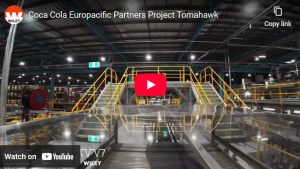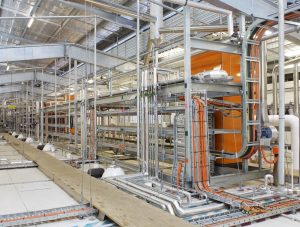
- Industry Type: Meat, Poultry, Industrial Manufacturing, Food Processing, Seafood
- Author: Peter Bullock
- Service Area: Advice, Design
- Date: 03 Apr 2012
In today’s economic environment, the meat, fish and poultry industry is increasing automation and closely monitoring key performance indicators (KPIs) to deal with operational issues and drive efficiency.
The protein processing industry, encompassing primarily meat, fish and poultry, involves raw material processed into high- and low-value finished products with waste left over. Manufacturers need to maximise profitability while at the same time fulfilling production volume targets.
Wiley encourages its clients and prospects to participate in discussions and ask questions to help them find the best facility solution for them that also aligns with their commercial goals. Many food industry clients, particularly process managers, are primarily concerned with reducing labour and the overall cost of the project. However, focusing too tightly on these factors can make it difficult to create a good business case that will win the hearts and minds of the decision makers and more importantly, owners and investors.
In considering the labour issue, it’s not simply a question of reducing manpower; it’s more a question of how best to use experienced, skilled and valuable staff. Improving productivity yields far greater rewards than simply reducing employee numbers. Labour is not the most costly item in the production environment and, other than shedding labour, companies have very little control over their overall labour costs. The same applies to the other standard fixed costs in the business.

One area where forward-thinking processors can gain control is in the handling and processing of the raw material. These are usually the most valuable asset in the business; however, with both the purchase and selling price set by market conditions, manufacturers have little or no scope to reduce them. In contrast, processors have a huge opportunity to control how the raw materials are processed and how much ends up as high-value primary product.
The aim here should be to ensure that as much raw material as possible is used for the primary product, rather than for waste or low-value product. The meat, fish and poultry industry tends to use a large amount of manual processing techniques that can lack quality, intelligent measuring systems. Some parts of the industry have not yet adopted the new technology and still perform a lot of functions manually, around tables, without measuring what they’re doing.
Operators are often under pressure to achieve throughput at the expense of quality and yield. They also get fatigued and performance varies as the shift progresses. In order for processors to produce more finished product from the raw material, intelligent automated processes are needed with management systems in place to monitor the process and provide live reports on the key performance indicators (KPIs). Where manual processes continue, these should be monitored using management systems, if necessary down to individual operators.
Throughput, yield and quality are three fundamental KPIs in a production environment. At the very least, these indicators should be set against each process stage and for individual operators where applicable.
Intelligent equipment that is compatible with manufacturing execution systems (MES) software is available offering complete integrated production solutions that incorporate plant-wide IT solutions.
Using this technology enables processors to focus on key performance indicators and drive through improvements, step by step. Furthermore, the reports this style of software provides are key tools that empower everyone to get involved in the process of achieving better results when made available to both management and operators. It is to everyone’s benefit; after all, a more profitable company should be a happier environment for all employees.

The range of automated processing equipment available today is comprehensive and offers unrivalled throughputs, accuracy and quality in processing. These range from fully-automated poultry cut up lines that separate virtually every product from the bird to automated intelligent portioning and packing systems for the meat industry that provide highly accurate portions by weight. In the salmon processing industry, automated whole fish grading and packing systems and automated fillet trimming robots are available. The list is almost endless.
The introduction of this type of automation has improved productivity; yield and product quality, while at the same time reducing labour and product giveaway in some instances. Such systems should always be linked to MES software for KPI monitoring and in turn MES can often be integrated with Enterprise Resource Planning (ERP) systems to provide the total company IT solution.
Today’s investment in tomorrow’s intelligent automated solutions combined with MES software can improve throughput, yield and quality. Funding can be a challenge on the pathway to this goal, but sound business cases can be prepared to show how new solutions can deliver improved KPIs. These cases should show payback periods in acceptable time frames and, more importantly, good indicators for net present value (NPV) over the coming years and very positive internal rates of return (IRR) for the investment.

Focusing on yield can offer greater financial benefit than simply reducing labour and the benefit stays and further improves year on year as experience extends the success of the solutions.
It is clear that processing environments are becoming increasingly intelligent and complex with more automated equipment and software in place. This inevitably means that more complex infrastructures and services are required in terms of power, water, air, data and waste management. Additionally, the increase in building and food production regulation means buildings that accommodate such processes need to be more highly specialised.
The days of shed- or warehouse-style buildings lined with food quality panels and a few drains in the floor have passed. Today’s meat, fish and poultry processes are complex and require factories that are not only specifically designed to suit their purpose but are also able to accommodate the latest in food processing technology. The design of facilities and process should go hand in hand to ensure the very best fit. This approach will ensure a better value proposition for investors, where improved financial benefits can be demonstrated to result from making the investment in improved processes and facilities.
About the author
Peter Bullock is a Business Development Manager at Wiley and can be contacted on 1300 385 988 or email connect@wiley.com.au.
This article was published in Food & Drink Business Magazine.
Download to read full article
To read this document you will need Adobe Reader


